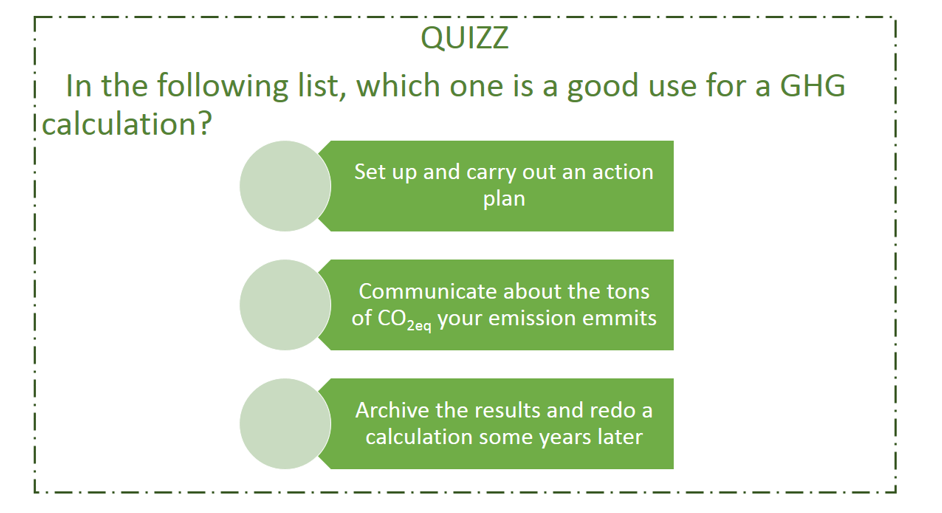- Accueil
- Actions!
- L'outil de calcul
- What to do with the results?
What to do with the results?
Formats and graphs
The Bilan Carbone© Clim’Foot tool allows to obtain the results in 4 different export formats :
-
the first is the CO2 overview (table format) representing the recapitulation of all calculations and results of all sheets;
-
the tool offers also the possibility to have the results according to the GHG Protocol and ISO 14069 recommendations. It is useful if you want to follow internationally standardized rules in matter of reporting;
-
and for more visual results, the last sheet contains a predefined graphs based on the calculation results.
Data are converted in tons of CO2 equivalent. Emissions are calculated and divided among the different categories. To properly exploit the results, it is important to make an analysis of uncertainties and review those with high results and high uncertainty.
A first analysis allows the user to identify the most emitting posts in which there is a priority to act. Significant emission categories should be defined only on the basis of their weight within the organization's GHG profile. It is the first step to define objectives and reduction actions.
For more details, see http://www.bilans-ges.ademe.fr/en/ressource/guide-sectoriel-list
Comparison between two calculations
If your organisation has already done a GHG emissions reporting, you can compare the results with the previous calculation and evaluate the impacts of the actions implemented.
Keep in mind that you can not directly compare two assessment : you have to check if perimeters and calcul hypothesis are the same for both reportings, in order for the results to show the real effect of your reduction actions.
Communicate about the results
Once the results are available, it is essential to do a restitution to the board meeting, the technical committee and maybe the employees involved in data collection. This step is an exchange time during which the presentation the GHG inventory with concrete figures will remind your stakeholders of climate change issues and will give them the required awareness about energy dependency and climate change vulnerabilities. Being aware of the Bilan Carbone© Clim’Foot results, the board meeting and the technical committee could contribute to define an action plan for GHG emission reduction of the organisation.
See the document "How to communicate about a Bilan Carbone© assessment" beside.
Organize a regular data collection
Your organization should implement a regular data collection to facilitate the GHG accounting. It is a mean to save time because the work is done gradually and to have accurate information. The focus on the most emitter posts is a first idea as it concerns the main targets of the actions developed.
Setting up a strategic monitoring
The development of a strategic monitoring is a part of the organization development strategy. First, it informs about risks and opportunities and allows the organization to anticipate external constraints regarding the law (obligation to do a GHG reporting, possible carbon tax). Second, your organization will be aware of new technology concerning GHG emission reduction and will assess its position compared to competitors. And finally, your organization will assess its business model to make it sustainable regarding climate change and energy issues.
Renewing the GHG accounting
To go further and to follow the impact of your emission reduction actions, your organization should plan a new GHG accounting and manage this renewal until it will happen. The objective is to integrate the GHG emission reduction in the overall analysis and to structure or develop the organization environmental policy.
The GHG accounting is a repeating exercise to continuously improve the organisation GHG emission reduction. It implies to:
-
Choose a reference period to use during the new GHG accounting
-
Update the reference period emissions checking the calculation and potentially improve the emission factors used accuracy
-
Rely on the reference period point of improvement to realize the new GHG accounting (choose the same duration)
To see the answer of the quizz, just move the mouse over the picture!
See the next page "More recent tools". Or return to the menu.

